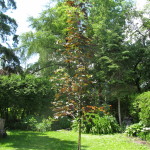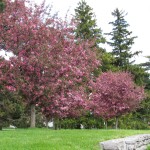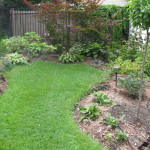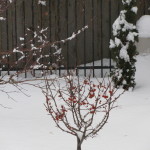A healthy urban forest has many benefits for:
– individual and property owners (seasonal beauty and interest, better air quality, stress reduction, privacy, food, reduced air conditioning costs, lower heating costs, higher property values, plus others), and
– the broader community (beautiful and healthy streetscapes, parks and public spaces, better water filtration, soil retention, less storm water run-off and need for infrastructure up-grades, amongst others).




Property owners can play an important role in enhancing the tree stock in the city, yet may have concerns about what trees can be selected to enhance their property.
Limited space available: Compact and columnar trees can thrive in smaller, urban spaces. Larger trees, which contribute most to the tree canopy, cooling and water retention, are best in larger spaces and allowed space to grow.
Avoiding damaging roots: Trees with fibrous roots (e.g. Red Oak, Star Magnolia, Regal Petticoat Maple) and taproots can adapt to varied uses nearby. Trees with invasive roots, such as some willows, should not be planted on urban lots.
The critical root zone of a tree needs protection during construction. For the long-term health of trees, root compaction by parking cars over tree roots or other competing uses, (e.g. buildings, in-ground pools) need to be avoided.
Unsure about caring for trees: Trees suited for the location (e.g. sun/shade, moisture, soil, wind, salt spray, and space) can stay healthy longer and avoid issues, such as competing with overhead wires. Native trees are good choices, though some new varieties and introduced species adapt better to urban conditions.
Also note:
– disease-resistant tree varieties are wise choices;
– planting a diversity of trees helps avoid disease and insect problems (e.g. Emerald Ash Borer (EAB)) which target commonly planted species and so leave large gaps in the landscape;
– avoid damage to the bark of young trees by grass trimmers and animals (e.g. use trunk wraps for winter);
– regular pruning of young trees can correct or avoid problems (e.g. broken or crossing branches) so trees remain healthy.
Information and advice on selection, installation and maintenance are available from professional services and other sources.
Not wanting to clean up leaves and fruit: Evergreens, which retain their needles and cones throughout the year, are an option. Other choices may include:
– trees which produce many flowers but no or little fruit (e.g. Lilac, Magnolia, some Mulberry);
– male trees which do not produce fruit (e.g. Ginkgo, Alpine Currant);
– persistent fruits which stay on the tree until harvested or eaten by birds (e.g. some Crabapple, Mountain-Ash);
– community groups (e.g. Hidden Harvest) can pick fruits and nuts for you, while sharing the rest with volunteers and those in need.




Reducing light to buildings: Trees should be selected and located so as to not block windows. Trees on the south or west sides of buildings can provide shade, cooler temperatures and reduce air conditioning costs during the summer. As days get shorter, deciduous trees lose their leaves and let more light into building interiors.
Evergreens provide protection from cold winter winds and help reduce winter heating costs, when placed on the north side of a building or in the direction of prevailing winds.
Purchase costs: Free trees are planted on city easements when property owners register with Ottawa’s Trees in Trust, or similar programs. Owners need to purchase trees for planting elsewhere, with costs varying by tree species, size, and other factors. Local nurseries, garden centres or other professionals can provide information.
Watering costs: Species selection is important since some trees need moist conditions (e.g. Birch, Tamarack) while others are more drought-tolerant (e.g. Lilac, Smoke Bush, Turkish Hazel). Young trees may need frequent watering while establishing. Older, larger, established trees can be particularly effective in reducing storm water run-off and helping reduce cooling and other costs.
Limits on what can grow under and around trees: Smaller trees, columnar trees and trees with taproots take up less horizontal space. Some other options:
– deciduous trees, which leaf out later in the spring and/or produce a dappled shade (e.g. Honey Locust), allow spring blooms, shade-tolerant grass, groundcovers and other plants to grow around them;
– shade-loving and drought-tolerant plants can be planted nearby;
– tubs filled with shade-loving plants can be set out and watered separately;
– a sitting area under a tree allows relaxation and enjoyment of the shade and garden.
Note: Grass, other plants and mulch should be kept away from tree trunks.
Also, a toxin of Black Walnuts kills some nearby plants but is tolerated by others.
Allergy problems: Trees are particularly good at cleaning the air of pollutants and producing life-sustaining oxygen. People with respiratory or skin problems triggered by particular trees, grasses or other plants should avoid them in the garden if possible. Try selecting trees which:
– do not produce large quantities of wind-borne, allergenic pollens (e.g. some deciduous and many conifers);
– flower during cool seasons (e.g. Star Magnolia (early spring), Witch Hazel (late fall));
– are insect-pollinated (e.g. Apples, Mountain Ash).
To avoid mould allergies, clean-up fallen leaves and cut down perennials before winter.
Conclusions: Property owners may have varied concerns about planting trees on their property. These can be addressed through good selection and placement of trees. Many resources can provide guidance and help.